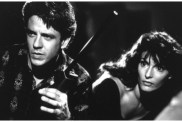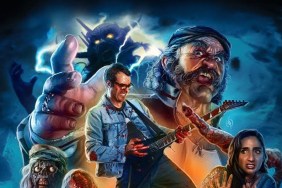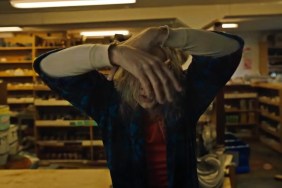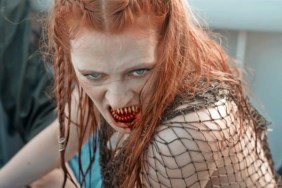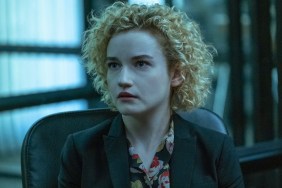
Full Eclipse aired in late November of ’93. That Fall didn’t give horror fans too much. A Nightmare Before Christmas and Brian Yuzna’s The Return of the Living Dead Part III opened the month prior (the latter in select theaters). Addams Family Values – a November ’93 release – was fun, but at home there wasn’t anything new for genre fans to really sink their teeth into other than Tales from the Crypt which was still enjoying its run on HBO.
I was in high school when Full Eclipse made its debut and I was already a fan of director Anthony Hickox, who had previously helmed Waxwork and its sequel, Sundown: The Vampire in Retreat and Hellraiser III: Hell on Earth. Horror movies, comic books and model kits were the world to me growing up and Full Eclipse hit at just the right time. Here was a film that catered to my tastes with its mix of gunplay, monsters and babes.
Now, before you go any further and think that this love letter to the film is based purely on nostalgia, I’ll tell you this: My ramblings are drawn a recent viewing when I picked the film up on DVD (the only way to get it – it comes in a snapper case!). Turns out, I loved the film then and I still love it now.
Written by Richard Christian Matheson (of the brilliant ’80s teen comedy Three O’Clock High) and Michael Reaves (writer of Batman: Mask of the Phantasm – arguably the best depiction of Batman on the big screen), Full Eclipse is one of those films of the early-’90s that depicts Los Angeles as helpless cesspool of violence and deviancy (much like Predator 2). As the opening credits roll, a single shot carries us across a building where, through an open window, we find a rotund slob of a man wiping his greasy mitts on his tank top before turning to a young girl who is waiting for him on a bed. Her hands are bound. This single shot continues downward before we can see what unspeakable things he’s about to do to her and it carries us to street level where gang members are fetishizing the guns they brandish.
I think you’re getting the picture here: Los Angeles needs someone to clean up its streets.

The man working towards that cause is Max Dire (Peebles) of the L.A.P.D. You know how committed this dude is to his job because his marriage is on the rocks and he kind of sucks at doing the whole “marriage counseling” thing. Catching “bad guys” (as he calls them) is his thing and he does it with the help of his partner Jim. But Jim doesn’t last long because during the film’s first action sequence, Jim is gunned down. Ah…but he’s back on his feet in spite of a grim prognosis (the guy was knocking at death’s door). How can this be? Well, it seems someone dosed Jim with a drug that boosts his energy, gives him uncanny strength and an awesome healing factor (like Wolverine). There’s a side effect, however, and Jim has a meltdown, killing himself in front of Dire and his colleagues (Break Bad‘s Dean Norris!).
Wallowing in sorrow and confusion, Dire is approached by a mysterious fella named Adam Garou (Bruce Payne) who wants to bring him into a support group for cops. And let’s see…besides Patsy Kensit, you’ve also got Paula Marshall and Jason Beghe (years before they each co-starred in Californication) as members of this team along with John Verea. Hickox, if you didn’t know, used Marshall for Hellraiser III as well. Kensit, meanwhile, was known for her turn in Lethal Weapon 2. She also did an episode of Tales from the Crypt (“As Ye Sow”).
Garou’s group are all users of this wonder drug that Jim was exposed to and they want Dire to join them in their fight against crime using the lycanthropic abilities the drug gives them. They don’t go full wolf, mind you. Instead, they sport fangs and giant claws protrude from their knuckles (again, LIKE WOLVERINE). The X-Men influence doesn’t stop there. Even the steal suits they wear have an uncanny resemblance to the costumes featured in the early-’90s X-Men comics.

Dire is resistant at first (he literally insists on a “Just Say No” defense), but Kensit’s “Casey” forces him into the group using extreme measures. What follows is an horror-fueled action movie that ultimately pits Dire against Garou, a man nurturing some very sinister plans.
With Matheson hailing from the writers pool on shows like The A-Team and Reaves coming off of cartoons like The Real Ghostbusters and Batman: The Animated Series (he later went on to Gargoyles), Full Eclipse is incredibly ambitious and efficient in its storytelling. Characters are finely drawn; they’re mostly broad portrayals that don’t get too deep, but we get just what we need to keep us satisfied. Everyone is up to the task to sell the story, too. Peebles plays it cool, but not over-the-top. He leaves the showboating to Bruce Payne who relishes the “alpha wolf” persona. Payne’s dedicated, you have to give him that. His body language here is spot-on for Garou. Keep an eye out for some unique physical choices when his team attacks a waterfront “gun party” or when he comes to learn Casey has slept with Dire. (Guess what? He’s not thrilled about it.)

Stylistically, director Hickox is true to form. Up to this point, he had always delivered something that was slick and kinetic. Full Eclipse is no exception, but what you’re seeing here is a director who obviously saw The Killer or Hard Boiled. On the budget he has, Hickox pulls off some Woo-like gun battles. Hell, there’s a moment when Dire miraculously jumps out of an air vent in slow motion, blasting away with two guns, hitting his target every time. He also has fun with a shootout in the streets of L.A. and a moment that finds Casey and Dire wolfing out to take on some bad guys. I wish there was more of the latter, but the story requires much of the budget go into the finale that features a large bipedal werewolf that looks more bear than wolf. Time, unfortunately, hasn’t been kind to this beast when you look at the FX (nor has it been kind to the Beavis and Butt-head reference that comes as a throwaway line in the film).
Some dated elements aside, Full Eclipse still works really, really well. It maintains its focus – being a film about werewolves and addiction (the latter a theme usually attributed to vampire films) – and is a hell of a lot better than it has any right to be. It opened itself up for a sequel, alas, that never happened. But upon a recent glance, the material certainly lays the foundation for a promising HBO series…

